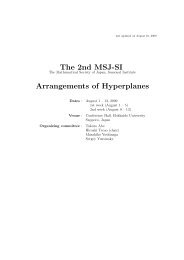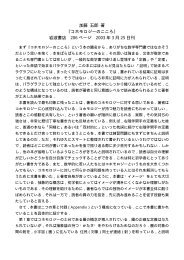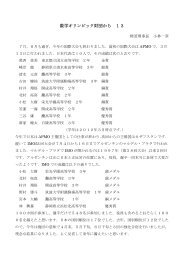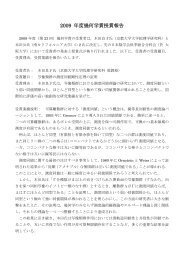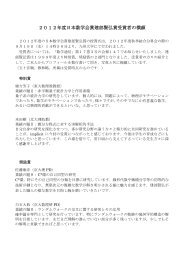Titles and Short Summaries of the Talks
Titles and Short Summaries of the Talks
Titles and Short Summaries of the Talks
Create successful ePaper yourself
Turn your PDF publications into a flip-book with our unique Google optimized e-Paper software.
29 Geometry<br />
Final: 2013/2/7<br />
17 Kotaro Kawai (Tohoku Univ.) ∗ Construction <strong>of</strong> coassociative submanifolds · · · · · · · · · · · · · · · · · · · · · · · · 10<br />
Summary: The notion <strong>of</strong> coassociative submanifolds is defined as <strong>the</strong> special class <strong>of</strong> <strong>the</strong> minimal<br />
submanifolds in G2 manifolds. We construct coassociative submanifolds in R 7 <strong>and</strong> <strong>the</strong> anti-self-dual<br />
bundle over <strong>the</strong> 4-sphere by using <strong>the</strong> symmetry <strong>of</strong> <strong>the</strong> Lie group action.<br />
18 Kota Hattori (Univ. <strong>of</strong> Tokyo) ∗ Generalizations <strong>of</strong> Taub-NUT deformations · · · · · · · · · · · · · · · · · · · · · · · · 15<br />
Summary: We introduce a generalizations <strong>of</strong> Taub-NUT deformations for large families <strong>of</strong> hy-<br />
perkähler quotients, which is already known to be defined for toric hyperkähler manifolds <strong>and</strong> ALE<br />
spaces <strong>of</strong> type Dk.<br />
19 Tomoyuki Hisamoto (Univ. <strong>of</strong> Tokyo) ♯ Geometry <strong>of</strong> <strong>the</strong> space <strong>of</strong> Kähler metrics, <strong>the</strong> relation between Calabitype<br />
functionals <strong>and</strong> <strong>the</strong> Donaldson–Futaki invariant. · · · · · · · · · · · · · · · 15<br />
Summary: Given a polarized Kähler manifold, we show that <strong>the</strong> algebraic norm <strong>of</strong> a test<br />
configuration equals to <strong>the</strong> norm <strong>of</strong> tangent vectors <strong>of</strong> associated weak geodesic ray in <strong>the</strong> space<br />
<strong>of</strong> Kähler metrics. Using this result, We may give a natural energy <strong>the</strong>oretic explanation for <strong>the</strong><br />
lower bound estimate on <strong>the</strong> Calabi functional by Donaldson <strong>and</strong> prove <strong>the</strong> analogous result for <strong>the</strong><br />
Kähler–Einstein metric.<br />
20 Nobuhiko Otoba (Keio Univ.) ♯ New examples <strong>of</strong> Riemannian metrics with constant scalar curvature<br />
· · · · · · · · · · · · · · · · · · · · · · · · · · · · · · · · · · · · · · · · · · · · · · · · · · · · · · · · · · · · · · 15<br />
Summary: We constructed a one-parameter family <strong>of</strong> Riemannian metrics on <strong>the</strong> non-trivial<br />
S 2 -bundle over S 2 . In a certain sense, <strong>the</strong>se metrics are <strong>the</strong> counterpart <strong>of</strong> <strong>the</strong> one-parameter<br />
family <strong>of</strong> natural product metrics on <strong>the</strong> trivial S 2 -bundle over S 2 . Every metric in <strong>the</strong> family has<br />
<strong>the</strong> following properties: (i) its isometry group contains <strong>the</strong> special unitary group SU(2), (ii) <strong>the</strong><br />
projection as fiber bundle is a Riemannian submersion with totally geodesic fibers onto <strong>the</strong> round<br />
2-sphere <strong>of</strong> some radius, <strong>and</strong> (iii) it has constant scalar curvature. We observe some <strong>of</strong> <strong>the</strong>se metrics<br />
are unique constant scalar curvature metrics in <strong>the</strong>ir respective conformal classes up to constant<br />
multiplication.<br />
21 Hajime Fujita (Japan Women’s Univ.) ♯ On an S 1 -equivariant index for symplectic manifold · · · · · · · · · · · · · · · · 15<br />
Summary: Using a technique developed in a joint work with M. Furuta <strong>and</strong> T. Yoshida we<br />
give a formulation <strong>of</strong> S 1 -equivariant index <strong>the</strong>ory for a prequantized symplectic manifold with a<br />
Hamiltonian S 1 -action. We explain <strong>the</strong> difference between our index <strong>and</strong> <strong>the</strong> index defined by<br />
M. Braverman.<br />
22 Masao Jinzenji (Hokkaido Univ.) ♯ 2 Multi-point virtual structure constants <strong>and</strong> mirror computation <strong>of</strong> CP -<br />
Masahide Shimizu (Hokkaido Univ.) model · · · · · · · · · · · · · · · · · · · · · · · · · · · · · · · · · · · · · · · · · · · · · · · · · · · · · · · · 10<br />
Summary: In this talk, we introduce multi-point virtual structure constants for <strong>the</strong> mirror<br />
computation <strong>of</strong> Gromov–Witten invariants <strong>of</strong> CP 2 . These constants are defined as <strong>the</strong> intersection<br />
numbers <strong>of</strong> <strong>the</strong> compactified moduli space <strong>of</strong> quasi maps from CP 1 to CP 2 with 2 + n marked<br />
points. Some <strong>of</strong> <strong>the</strong> generating functions <strong>of</strong> <strong>the</strong>se invariants correspond to <strong>the</strong> mirror maps <strong>and</strong> <strong>the</strong><br />
o<strong>the</strong>r generating functions are translated into <strong>the</strong> generating functions <strong>of</strong> genus 0 Gromov–Witten<br />
invariants <strong>of</strong> CP 2 . We also discuss <strong>the</strong> mirror computation <strong>of</strong> <strong>the</strong> open Gromov–Witten invariants<br />
<strong>of</strong> CP 2 .




